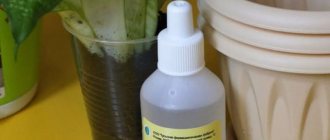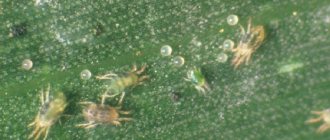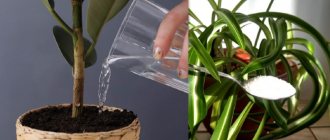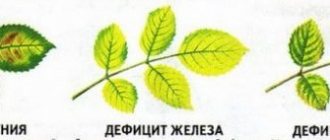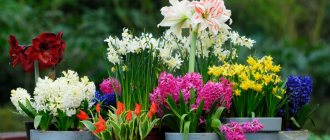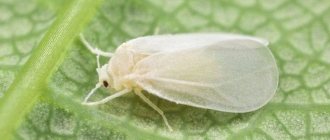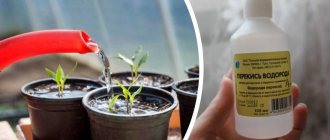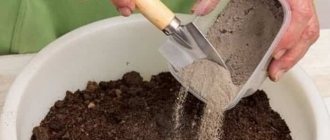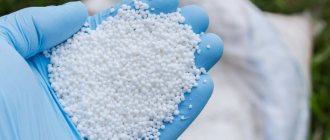Instructions for using vodka against aphids
Any vodka, alcohol or moonshine is suitable for spraying plants. You can use the “heads” of moonshine (the upper fraction), which still cannot be distilled again.
Treatment of garden plants should be carried out in the evening, at sunset, when insects become inactive. In bright sunlight, there is a high chance that plant leaves will get burned.
When spraying, you need to try to ensure that the liquid wets the leaves both above and below: pests often hide on the underside of the leaf blade. The water for preparing the solution should be warm (+25–27 °C).
Laundry or special green soap (sold in gardening stores) must be added to the spraying solution at the rate of 20 g of crushed soap per 1 liter of liquid. Soap shavings are first dissolved in a small amount of warm water and then mixed with the rest of the liquid.
Soap has a triple function:
- serves as an adhesive;
- compacts the leaves, making them “waxy”, which is why the pest cannot pierce them;
- clogs the breathing holes of aphids.
Fridge
There is a trick that will preserve your flowers longer than any other method. Just place the vase of flowers in the refrigerator overnight. Lower temperatures slow down the ripening process of flowers.
The refrigerator also cools the flower heads, preventing them from drying out and wilting. Keeping flowers cool overnight (eight hours or more) will keep them looking as good as the day you bought them in the store or cut them from your garden.
Found a violation? Report content
Acceleration of maturation
A study of the effect of ethanol on the ripening of tomatoes was carried out back in 1934 by Soviet botanists S.V. Soldatenkov and M.G. Kubli. During the experiment, alcohol solution in various concentrations was injected into unripe fruits during their growth and the results were observed.
As a result, scientists were able to speed up the process by 8-16 days, and the processed tomatoes tasted no different from regular ones. Subsequently, M. G. Kubli continued his experiments and two years later even published a fundamental work on this topic, but the experiments did not receive practical application.
Accelerated ripening after spraying with alcohol-containing solutions is explained by the fact that ethanol, under the influence of enzymes, releases ethylene, a powerful growth stimulant. This volatile gas in low concentrations activates the formation of the root system, promotes flowering, and accelerates the ripening of fruits. In nature, plants synthesize ethylene naturally, and scientists classify it as one of the types of phytohormones.
Vodka - food for fresh cut flowers
Cut flowers lose their original freshness due to the absence of a root, from which the plant receives nutritious moisture. Another reason for wilting is the proliferation of bacteria. A few drops of vodka and a piece of sugar will help prevent the spread of pests and provide the flowers with the necessary nutrition: they must be added to the water with the flowers. It is necessary to change the water every day, the alcohol evaporates quickly, and the sugar is absorbed by the stems.
How to feed peppers and eggplants with yeast
Recipes for feeding seedlings of peppers and eggplants do not differ from those described above. But fertilizer for open ground vegetables varies somewhat in composition. For them, first of all, you can prepare a “herbal cocktail”. Prepare 1 bucket of herbs (plantain, hops, nettle, etc.), add 0.5 kg of bread or crackers and 0.5 kg of baker's yeast. Pour the ingredients into 50 liters of water and let the contents brew for two days.
A good starter is prepared from 100 g of live yeast, 50-70 g of sugar, 0.5 liters of ash and 0.5 liters of chicken manure extract. Dilute all this with 10 liters of water and apply at least 2 liters of concentrate under each plant.
Which indoor flowers can be watered with vodka and how to water them correctly
These types of house plants can be watered with a vodka solution:
- Asparagus: grows and develops quickly if you water it with a weak vodka solution once every two weeks (1-2 tbsp per 1 liter of water).
- Monstera: prefers a weaker solution (1-2 tbsp per 2 liters of water). The frequency of applying fertilizer is 1-2 times a month.
- Ficus benjamina: often begins to lose leaves for no reason. In fact, he needs alcohol supplementation. Dilute 1 tbsp. l. for 250 ml of water. Such procedures are carried out once every 2 weeks. After four feedings, the plant comes to life and grows abundantly with new leaves.
- Some varieties of cacti and palm trees: prefer an alcoholic drink in a ratio of 1 tbsp. l. for 1 liter of water. Water once a month.
- Violets: when powdery mildew appears on them, it is necessary to spray them with vodka water, the disease will not spread throughout the plant. In 5-6 sprayings with an interval of 4-5 days, the plant takes on its previous appearance. This should be done at the very beginning of the disease (1 tbsp per 200 ml of water).
- Regular ivy: a climbing plant that climbs walls and stairs, does not mind this fertilizer. Its growth increases, the leaves acquire a juicy color and thickness. It is enough to feed once a week (2 tablespoons per 3 liters of water).
Houseplants that are very sick from pest attacks are treated with a solution of vodka and laundry soap in a one-to-one ratio. The composition is sprayed onto the foliage, left for 30 minutes, and washed off. Perform from two to four treatments. After such care, the plant recovers.
All gardeners want their favorites to have bright and juicy foliage. To do this, spray with a solution of camphor alcohol: 2-4 drops per liter of water.
Help: flowers are fed, not overfed. If there is an excess of fertilizer, growth processes are disrupted and the flower may die.
Alcohol flower feeding is used like everyone else, following the rules:
- apply fertilizer from early April to mid-October;
- in winter, their number is gradually reduced, reduced to a minimum;
- They begin to feed when the plant withers and feels a lack of nutrients;
- use fertilizer if the plant’s growth has stopped or it has not bloomed for a long time;
- feed when the flower drops its leaves for no reason or looks sick.
Important: you cannot apply fertilizing to dry soil, as you can burn the roots of the plant.
Caring for indoor flowers is not an easy and troublesome task. True lovers of this hobby will always find the right approach using different fertilizers. Today flower growers got acquainted with another equally important and original one.
How to feed tomatoes with yeast
Tomato, like no other crop, “loves” feeding with fresh yeast. However, not all gardeners know how to properly feed small bushes of young tomatoes in open ground with yeast:
The recipe for preparing the mixture in both cases is identical: dilute 10 g of dry yeast in 10 liters of water, add 0.5 liters of wood ash, 0.5 liters of chicken manure extract (infused for 3 days in a ratio of 1:10 with water) and 5 tbsp. . Sahara. After a few hours, dilute the already obtained infusion with water in a ratio of 1:10 and pour it over the bushes around the circumference at the rate of 0.5-2 liters per plant. It is best to water from a watering can with a strainer at some distance from the shoots so as not to damage the root system.
Treatment of seedlings with vodka
Even with proper preparation of the soil for seedlings, there is a risk of infection with fungal diseases, since spores can be introduced with purchased soil. Young tomatoes are most often affected by the black leg at the bottom of the stem. If signs of disease are noticed on one sprout, the entire batch requires urgent treatment.
Procedure:
- Dilute 1 tablespoon of vodka in 1 liter of warm water.
- Water the seedlings at the root once.
The method prevents the development of the disease and serves as an additional impetus for growth and strengthening of the immune system. To protect the seedlings already at the stage of emergence on the surface, they are sprayed with moonshine or vodka diluted with water in a ratio of one to ten. The method is effective for seedlings of cabbage, asters and nasturtiums.
Adding wood ash
This folk remedy can normalize soil acidity and is a source of potassium, calcium, and phosphorus. Ash can be added in the next season after planting. To feed the bushes with ash “by leaf”, you need to dilute 1 glass of this product in a bucket of water. When applying “under the root,” you need to dilute 2 cups of ash in a bucket of water.
10 wild flowers for a flower bed that will become a wonderful decoration for the site
You can add an ash solution simultaneously with yeast feeding, since yeast consumes too much potassium from the soil, which needs to be replenished immediately.
Vodka against pests, diseases and weeds
Watering with vodka is used as an unconventional way to combat aphids and the Colorado potato beetle. Ethanol blocks the respiratory tract and causes disruption of the central nervous system of insects. Treated plants acquire an unpleasant odor and become bitter, which forces pests to leave the area. The advantages of the method are its environmental friendliness. Ethyl alcohol, unlike insecticides, is safe for humans and pets.
Vodka for plants serves as an antiseptic and is used to improve soil health and fight fungal diseases. Ethanol kills spores and prevents their spread. Alcohol solutions are also used to control weeds in small areas.
Vodka disinfects the soil
Irrigating the soil with ethyl alcohol stimulates the development of seeds that are in the ground. Subsequent weeding allows you to remove all the weeds at one time, after which the soil remains clean for a long time.
Recipes for preparing alcohol-based aphids
Tender young foliage, herbs, and flowers are afraid of burns, while the trunk and branches of trees and shrubs can be treated at any time. Therefore, you will need several options for preparing a solution of different concentrations.
Different concentrations of alcohol are used to treat different plants.
Strong solution
Prepare as follows:
- warm water (25-30 degrees Celsius) – 1 l;
- vodka – 300 ml (it can be replaced with 150 ml of alcohol 96 degrees);
- laundry or green soap – 20 gr.
This concentration is used only for fruit bushes and trees. The trunk and branches are processed with a brush. The spray can be used in the fall or early spring before new leaves appear.
If solid laundry soap is used in the process of preparing the solution, then it must be crushed and first dissolved separately in a small amount of water, and then added to the total mass. The soap allows the solution to remain on the surface of the plant longer. It creates a protective film that makes it difficult for insects to feed and clogs the respiratory tract of pests.
Weak solution
To prepare this aphid remedy you will need:
- warm water (25-30 degrees Celsius) – 1 l;
- vodka – 100 ml (can be replaced with 50 ml of alcohol 96 degrees);
- laundry or green soap – 20 gr.
A lightweight version of the solution can be used to treat any crops.
Coca-Cola solution (weak)
The Coca-Cola drink must first be rid of carbon dioxide. To do this, you can pour it into a wide container or jar and leave it for a day so that the gas evaporates.
Mixing Ingredients:
- Coca-Cola – 1 l;
- vodka – 100 ml (or 50 ml of alcohol 96 degrees);
- laundry or green soap – 20 gr.
The acids contained in Coca-Cola in combination with alcohol have a detrimental effect on aphids. In addition, the sweetness of the drink helps the product stay on the surface of plants longer, which increases the period of its effect on parasites.
Oil solution (weak)
Refined sunflower oil is used to prepare this alcohol solution against aphids. You can’t take unrefined ones, as the strong smell can attract other pests, such as mole crickets.
The solution contains:
- warm water (25-30 degrees Celsius) – 1 l;
- refined sunflower oil – 300 ml;
- vodka – 100 ml (or 50 ml of alcohol 96 degrees);
- laundry or green soap – 20 gr.
The thinnest film formed due to vegetable oil disrupts the respiratory function of insects, and they die.
The spraying procedure with a warm solution should be carried out in the late evening, when the aphids stop actively moving. You need to process greens carefully, paying special attention to the underside of the leaf, where insects most often settle.
How to use alcohol, vodka, moonshine against aphids: concentration
Alcohol is a rather strange substance for controlling aphids. As it turned out, this substance affects the body of insects that absorb alcohol. Due to this, there is a significant effect on the insect’s nervous system, which contributes to impaired coordination of movements and digestion.
How to use alcohol, vodka, moonshine against aphids, concentration:
- It is necessary to dissolve approximately 250 ml of vodka in 1000 milliliters of warm water. Add 20 g of soap shavings. Mix everything and process. This product is ideal for trees and shrubs. This product should not be used to spray vegetable crops such as cucumbers, tomatoes and peppers.
- For vegetable crops, you need to dissolve 100 g of vodka and 20 g of soap in one liter.
- There is another good recipe based on Coca-Cola. Pour about 1000 ml of the product into a jar and leave to stand for about 12 hours so that the carbon dioxide completely evaporates. Pour 100 ml of vodka into the product, add a little soap. The drink contains a large amount of phosphoric acid, which is destructive to aphids.
- Vegetable oil works well with vodka. It is necessary to dissolve approximately 250 ml of oil in one liter of warm water and add 100 g of vodka. Shake the mixture and apply to leaves and stems using a spray bottle. The alcohol itself evaporates very quickly, so the main task is to promote the adhesion of the alcohol to the leaves. It is for these purposes that vegetable oil or soap is added to the mixture. They create a thin film on the surface of the leaves, which does not allow insects to penetrate inside the plant, sucking out its juices. Alcohol drives away insects due to its strong odor and affects the nervous system.
Spraying
Properties of ammonia
Ammonia is a colorless liquid that has a very specific and very pungent odor. As a rule, the pharmacy sells concentrated formulations with 10% ammonia.
Drugs of this type are widely used in medicine to bring a person back to his senses after loss of consciousness. Ammonia solution is also used by flower growers to care for plants that are in an apartment or country house.
Ammonia is a combination of ammonia gas as well as water. It contains about 82% nitrogen. Therefore, it is very often used as a nitrogen fertilizer, which is suitable for garden and other crops.
Ammonia is capable of:
- Accelerate the process of gaining green mass.
- Improve plant health.
- Reduce the amount of accumulated nitrates that form in plants. This happens if the grower uses urea and ammonium nitrate.
- Cause much less harm to a person who uses this type of fertilizer. Ammonia does not contain toxic components, like other chemicals that gardeners often use.
- Increase the productivity of fruit and vegetable crops.
Ammonia can be used as a variety of additives that not only fertilize the soil, but also help get rid of pests and diseases. If you correctly observe the concentration of the solution, as well as the frequency of applying such additives, then in this case the plants will not be harmed.
However, you need to understand that ammonia cannot completely replace standard nitrogen fertilizers. As a rule, if the plant is already affected by chlorosis or other diseases, then an ammonia solution cannot correct the situation. Therefore, this substance is most often used for protection and prevention. This remedy is also effective in case of nitrogen deficiency.
This problem can be identified by several signs:
- The leaves of the flowers become more wrinkled and gradually turn yellow.
- The growing season fails and the plants begin to grow very slowly.
- The leaf blades take on a paler hue, and the stem becomes brittle.
With such signs, it is necessary to apply nitrogen fertilizers. Experienced gardeners prefer to use a 25 percent ammonia solution for this. It cannot be bought at a pharmacy, but only in specialized stores, for example, those that sell various chemicals. But you should use such concentrated ammonia only in case of urgent need.
If the concentration is incorrectly calculated, it can cause serious harm to the flowers.
Ammonia for indoor flowers, the use of which will accelerate the growth of plants, is a cheap remedy. It contains several useful elements.
| Substance | Peculiarities |
| Phosphorus | This component is responsible for the development of green mass. In addition, phosphorus improves the protective properties of the plant and promotes the development of the root system. |
| Potassium | This substance is necessary for plants to receive sufficient moisture. Potassium takes part in the process of photosynthesis and gas exchange. |
| Nitrogen | It is necessary for the quality of life of the plant, as it also takes part in activating the growth of the green parts of indoor flowers. In addition, nitrogen is part of chlorophyll. |
Nitrogen stimulates the growth of green mass, but in case of oversaturation with this component, foliage growth begins to be too active. This leads to the fact that the plant begins to weaken, since the root system and stem do not develop so quickly.
Such an imbalance leads to the fact that the flower begins to weaken, wither and may gradually die. Ammonia contains substances that affect not only the growth of foliage, but such an additive should be used sparingly.
The big advantage of using an ammonia solution is that this component is superfluid. Thanks to this, water begins to penetrate into almost all areas of the soil that is in the flower pot. This allows the plant root system to be fully nourished.
Under natural conditions, flower rhizomes are able to grow independently as much as they need to obtain sufficient nutrition. However, in conditions of growing in an apartment, this is excluded, since the root system is limited to the space of the flower pot.
If you replant the plant every spring, this also does not solve the problem, since after a few months the flower will need additional feeding or another transplant, which is also not a good solution. Due to too frequent movement from one pot to another, the root system is injured and the flower in any case becomes weaker.
If you transplant flowers immediately into larger pots, this will only provoke the growth of the root system, but the required amount of nutrients will still not be formed in the soil, as in nature. Geraniums especially often suffer from this problem. You can correct the situation using ammonia.
How to use alcohol against aphids on currants?
The choice of product concentration depends on the growing season. As for currants, it is necessary to spray them several times a season. If buds have just appeared on the bush, it is best to use a recipe with a high concentration of alcohol.
How to use alcohol against aphids on currants:
- In this case, it is necessary to add 300 or 250 ml of vodka per 1000 ml of water. If the currants are blooming or the first berries have appeared, it is best to use less alcohol.
- For 1000 ml of solution, 100 ml of vodka is enough. Use a strong solution before flowers and berries appear, and reduce the alcohol concentration if the plant blooms.
Aphid
Treating seeds with alcohol
Some summer residents have long been using vodka to germinate seeds that are difficult to germinate (parsley, carrots, cilantro). The fact is that alcohol dissolves the essential oils contained on the surface of the seeds, which make germination difficult. Just keep the seeds in a shot glass with vodka for 5 minutes and then dry them. After soaking in vodka, the seeds can be planted in the usual way.
How to treat aphids with vodka on fruit trees?
Alcohol or vodka are great for spraying trees. The concentration is selected according to the same principle as for currant bushes.
How to treat aphids with vodka on fruit trees:
- After the leaves appear, you need to dissolve 300 ml of vodka in 1000 ml of warm water and add soap shavings. Spraying with this solution is carried out. During the flowering period, you must choose a solution that contains only 100 ml of alcohol per 1000 ml of water.
- With the help of vodka, not only spraying is carried out, but also unique traps are made that block the path of ants. To do this, you need to take a tape approximately 20-30 cm wide and wind it in a circle.
- It is necessary to moisten the tape with the prepared vodka solution. You can wrap the trunk with tape with fly strips. Insects will stick to the tape and will not be able to cause significant damage to the trees.
Treatment
Effective recipes
Various solutions using vodka in the composition also help to combat aphids.
First, it is better to test the effect of the liquid on a small area, for example, on one shoot. If burns appear after a day, the concentration of vodka should be reduced.
With soap shavings
For spraying, detergents are added to the vodka. Both household soap and specialized green soap, sold in gardening stores, are used. The proportions are as follows: dissolve 20 g of soap shavings in 1 liter of warm water, then add 300 ml of vodka or 150 ml of alcohol.
With soap
In addition to soap shavings, just soap is also used. The ratio is the same as in the case of soap shavings: 20 g of a piece of soap per liter of water and 150 ml of alcohol or 300 ml of vodka.
On a note! Liquid soap can also be used.
With Coca-Cola
The destructive effect of the popular American drink on aphids is explained by the presence of orthophosphoric acid in the composition, which is poisonous to them. This solution is prepared by combining equal parts of Coca-Cola and vodka. In addition, 20 g of soap and 100 ml of vodka can be diluted in a liter of Coca-Cola. It is advisable to keep Coca-Cola open for a day before this so that the gas escapes.
With vegetable oil
Another recipe for eliminating aphid colonies is to treat the affected plants with a mixture of vodka, soap and vegetable oil. To create this folk solution, take 100 ml of vodka, 300 ml of vegetable oil and 20 g of soap per liter of water.
The film that is formed with vegetable oil interferes with the respiratory processes of aphids. It is important to know that the smell of refined oil can attract mole crickets, so it is better to use unrefined oil.
On a note! Warm water is used to prepare these solutions.
Sources
- https://alcofan.com/kak-izbavitsya-ot-tli-vodkoj-i-spirtom.html
- https://alcofan.com/kak-i-zachem-opryskivat-rasteniya-vodkoj.html
- https://raznoe-poleznoe.ru/vodka-kak-podkormka-dlja-komnatnyh-cvetov.html
- https://MoiOrhidei.ru/sovet/ai-predstavit-ne-mogla-cto-cvety-mogut-lubit-vodku-pricem-kak-svezesrezannye-tak-i-zivye
- https://slavarod.ru/vrediteli/poliv-i-obrabotka-rastenij-vodkoj
- https://vsadu.ru/post/obrabotka-spirtom-ot-tli-recepty-primenenie.html
- https://heaclub.ru/vodka-spirt-samogon-ot-tli-na-derevyah-smorodine-ogurcah-percah-kapuste-kak-ispolzovat-otzyvy-nashatyrnyj-spirt-ot-tli-na-ogurcah-instrukciya- otzyvy
- https://GdeKlop.ru/tlya/opryskivaniya-vodkoj/
[collapse]

